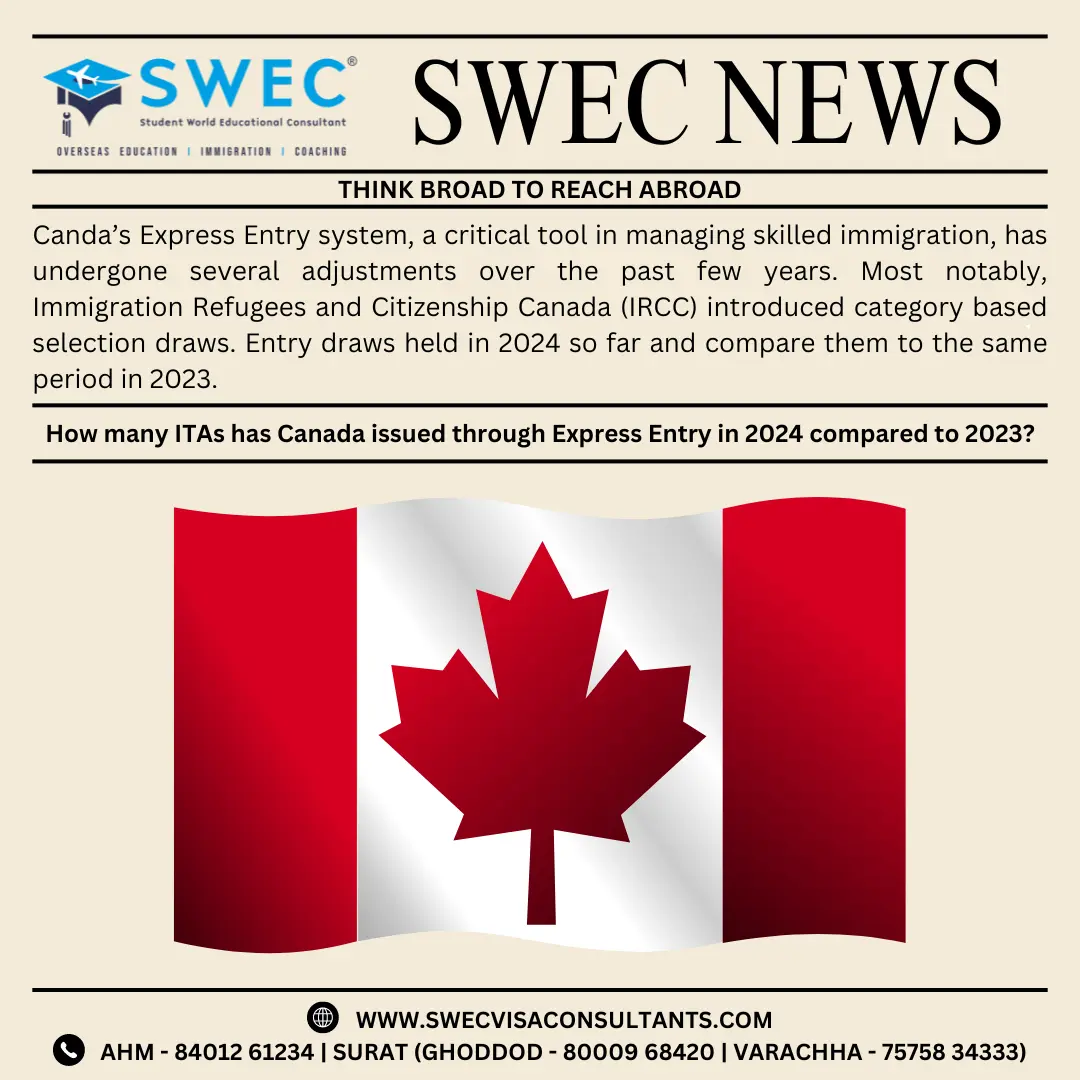Canada’s Express Entry system, a critical tool in managing skilled immigration, has undergone several adjustments over the past few years. Most notably, Immigration, Refugees and Citizenship Canada (IRCC) introduced category-based selection draws in 2023, allowing for more targeted immigration invitations based on the country’s economic needs and demographic priorities. This change marks a significant evolution in how Canada selects immigrants, with a shift from a generalized points-based system to a more specialized approach.
In this article, we will dive deep into the data and trends behind the Express Entry draws held in 2024 so far and compare them to the same period in 2023. We will also discuss how these changes are shaping Canada’s immigration landscape and impacting both potential immigrants and the Canadian economy.
Table of Contents
What is Express Entry and Why is it Important?
Express Entry is an immigration selection system used by Canada to manage applications for permanent residency. It operates primarily for three key economic immigration programs:
- Canadian Experience Class (CEC): For candidates with skilled work experience in Canada.
- Federal Skilled Worker Program (FSWP): For individuals with skilled work experience abroad.
- Federal Skilled Trades Program (FSTP): For individuals with experience in specific trade occupations.
The system ranks candidates using a Comprehensive Ranking System (CRS), which assigns points based on various factors, including age, education, work experience, and language ability. Until 2023, IRCC primarily used CRS scores to select candidates for immigration, but recent changes have made the process more focused and goal-oriented.
Introduction of Category-Based Selection in 2023
In 2023, IRCC introduced category-based selection draws to better align immigration with Canada’s labor market needs. This new policy allows the immigration department to target candidates with specific human capital attributes such as work experience in high-demand sectors or advanced language skills. This shift was designed to address critical labor shortages, particularly in sectors such as healthcare, STEM, trades, and transportation.
The key categories that IRCC currently targets include:
- Healthcare occupations
- Science, Technology, Engineering, and Mathematics (STEM) occupations
- Trade occupations
- Transport occupations
- Agriculture and agri-food occupations
- French language proficiency
Category-based selection allows Canada to remain globally competitive by ensuring that the immigration system directly supports economic growth and fills the gaps in the workforce.
Number of ITAs Issued in 2024 Compared to 2023
As of September 19, 2024, Canada has issued a total of 84,874 Invitations to Apply (ITAs) through Express Entry. By the same date in 2023, the number was 81,948, meaning there has been a modest increase of about 3.6% in the total ITAs issued this year.
This increase reflects Canada’s ambitious immigration targets. In 2023, Canada set a goal of welcoming 82,800 new immigrants through the Express Entry system. However, in 2024, this target rose significantly to 110,770 immigrants, a nearly 34% increase. This higher target is in line with Canada’s strategy to address labor market shortages and support economic recovery post-pandemic.
In 2024, we’ve also seen a greater variety of categories and streams being used in the selection process, which contrasts with previous years when the No Program Specified draws dominated.
Comparison of Express Entry Draws: 2024 vs. 2023
The following table breaks down the number of draws and ITAs issued across different categories and streams up until September 2024, and compares this with the same period in 2023:
| Category/Stream | Number of Draws (2024) | ITAs Issued (2024) | Number of Draws (2023) | ITAs Issued (2023) |
| Agriculture and Agri-Food Occupations | 0 | 0 | 1 | 150 |
| Canadian Experience Class (CEC) | 6 | 24,800 | 0 | 0 |
| Federal Skilled Worker Program (FSWP) | 0 | 0 | 1 | 3,300 |
| French Language Proficiency | 8 | 20,400 | 3 | 6,900 |
| Healthcare Occupations | 2 | 7,250 | 2 | 2,000 |
| General (CEC, FSWP, FSTP) | 9 | 14,445 | 0 | 0 |
| No Program Specified | 0 | 0 | 15 | 63,900 |
| Provincial Nominee Program (PNP) | 8 | 10,554 | 4 | 2,848 |
| STEM Occupations | 1 | 4,500 | 1 | 500 |
| Trade Occupations | 1 | 1,800 | 1 | 1,500 |
| Transport Occupations | 1 | 975 | 1 | 1,000 |
Streams and Categories with the Most Activity in 2024
A breakdown of the streams and categories that have been most active in 2024 is insightful. Some of the key trends include:
- Canadian Experience Class (CEC) has had six draws in 2024, issuing 24,800 ITAs. Interestingly, there were no CEC-specific draws by this time in 2023.
- The Provincial Nominee Program (PNP) has seen eight draws this year, issuing 10,554 ITAs. In comparison, there were only four PNP draws in 2023 by this point, issuing 2,848 ITAs.
- French Language Proficiency has emerged as a critical stream, with eight draws in 2024 issuing 20,400 ITAs. This is a marked increase from 2023, which saw only three French-language draws issuing 6,900 ITAs.
The increase in CEC and PNP draws reflects a broader shift toward “domestic draws,” following remarks by Immigration Minister Marc Miller. He emphasized the importance of prioritizing candidates already in Canada or with strong domestic ties, which is reflected in the increased focus on CEC.
Similarly, the rise in French language proficiency draws aligns with Canada’s goal of increasing the proportion of French-speaking immigrants outside of Quebec, with a target of 8% by 2026.
CRS Cut-off Scores for Key Categories in 2023 vs. 2024
Another important factor to consider when comparing the two years is the CRS cut-off scores, which determine which candidates receive ITAs. The following table shows the highest and lowest CRS cut-offs for selected categories in both 2023 and 2024:
| Category/Stream | Highest CRS Cut-off (2024) | Lowest CRS Cut-off (2024) | Highest CRS Cut-off (2023) | Lowest CRS Cut-off (2023) |
| French Language Proficiency | 446 | 336 | 439 | 375 |
| Healthcare Occupations | 445 | 422 | 476 | 463 |
| Provincial Nominee Program | 739 | 663 | 791 | 691 |
The CRS cut-off scores fluctuate depending on the pool of candidates and the needs of the immigration system. For example, the French language proficiency category has seen a lower cut-off this year compared to 2023, indicating that IRCC is more willing to extend ITAs to French-speaking candidates, even if their CRS score is lower.
The Importance of Category-Based Selection for Canada’s Future
The introduction of category-based selection reflects Canada’s commitment to meeting its labor market needs while maintaining its competitive advantage in attracting top global talent. By focusing on specific categories like healthcare, STEM, and trades, Canada is positioning itself to meet the demands of critical sectors facing shortages of skilled workers.
Moreover, the increased focus on French language proficiency shows Canada’s dedication to fostering bilingualism outside Quebec. This also supports the goal of increasing the share of French-speaking immigrants, which is a priority for maintaining the country’s cultural and linguistic diversity.
Conclusion
The data clearly shows that 2024 has been a more dynamic year for Express Entry compared to 2023, with more draws, higher immigration targets, and an increased focus on specific labor market needs. As Canada continues to evolve its immigration system to meet economic demands, it is likely that category-based selection will play an even more prominent role in shaping the country’s immigration policy.
If you’re interested in applying for Express Entry or want to assess your eligibility, consider consulting with professional immigration experts like SWEC Visa and Immigration Services. Our team can guide you through the latest Express Entry changes and ensure your application meets all requirements for a successful outcome.
For potential immigrants, it’s crucial to stay informed about these changes, as they could impact your chances of receiving an ITA. Understanding the nuances of category-based draws and keeping track of CRS trends can significantly improve your chances of being selected for permanent residency in Canada.
Stay tuned for more updates and analysis on Canada’s immigration system, including ongoing developments in Express Entry.
FAQs
Q1. What is Express Entry?
Ans1. Express Entry is Canada’s online immigration system used to manage applications for permanent residency from skilled workers. It operates through three main programs: the Canadian Experience Class (CEC), the Federal Skilled Worker Program (FSWP), and the Federal Skilled Trades Program (FSTP).
Q2. What are category-based selection draws in Express Entry?
Ans2. Category-based selection draws allow Immigration, Refugees, and Citizenship Canada (IRCC) to invite candidates based on specific criteria such as professional experience or language proficiency, rather than relying solely on their Comprehensive Ranking System (CRS) score.
Q3. What categories are used in Express Entry’s category-based selection draws?
Ans3. The categories for selection draws in 2024 include healthcare occupations, STEM (Science, Technology, Engineering, Mathematics) occupations, trade occupations, transport occupations, agriculture and agri-food occupations, and French language proficiency.
Q4. How many Invitations to Apply (ITAs) has Canada issued through Express Entry in 2024 compared to 2023?
Ans4. As of September 19, 2024, Canada has issued 84,874 ITAs, compared to 81,948 ITAs by the same time in 2023, reflecting a 3.6% increase.
Q5. Why has there been an increase in ITAs issued in 2024?
Ans5. The increase in ITAs is due to Canada’s higher immigration targets for 2024, aiming to welcome 110,770 immigrants through Express Entry, up from 82,800 in 2023. IRCC has also focused on category-based draws to address labor shortages.
Q6. How many draws has IRCC held in 2024 compared to 2023?
Ans6. By September 2024, IRCC has held 37 draws across nine categories and streams, while by the same time in 2023, IRCC held 28 draws across eight categories and streams.
Q7. Which Express Entry categories had the most draws in 2024?
Ans7. The Canadian Experience Class (CEC) and Provincial Nominee Program (PNP) categories had the most draws in 2024. There have been 6 CEC draws issuing 24,800 ITAs, and 8 PNP draws issuing 10,554 ITAs so far in 2024.
Q8. What has changed with French language proficiency draws in 2024?
Ans8. French language proficiency draws have increased significantly in 2024, with 8 draws issuing 20,400 ITAs compared to just 3 draws issuing 6,900 ITAs in 2023. Canada aims to increase French-speaking immigration outside Quebec to 8% by 2026.
Q9. How do CRS scores differ between 2023 and 2024?
Ans9. The CRS cut-off scores have varied across categories, with notable decreases in 2024. For example, the French language proficiency category’s lowest cut-off score in 2024 was 336, while it was 375 in 2023. Healthcare occupations also saw a drop, with a low of 422 in 2024 compared to 463 in 2023.
Q10. What are Canada’s immigration goals through Express Entry in 2024?
Ans10. Canada aims to meet its labor market needs by focusing on targeted immigration through category-based draws. The government seeks to address skill shortages in critical sectors such as healthcare, STEM, and trades, while also boosting French-speaking immigration outside Quebec.




